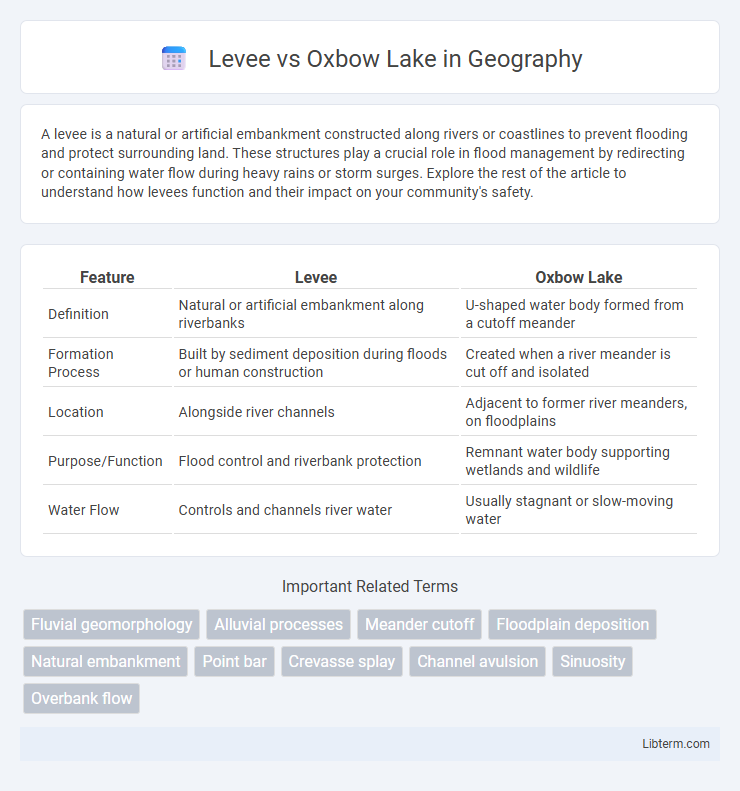A levee is a natural or artificial embankment constructed along rivers or coastlines to prevent flooding and protect surrounding land. These structures play a crucial role in flood management by redirecting or containing water flow during heavy rains or storm surges. Explore the rest of the article to understand how levees function and their impact on your community's safety.
Table of Comparison
| Feature | Levee | Oxbow Lake |
|---|---|---|
| Definition | Natural or artificial embankment along riverbanks | U-shaped water body formed from a cutoff meander |
| Formation Process | Built by sediment deposition during floods or human construction | Created when a river meander is cut off and isolated |
| Location | Alongside river channels | Adjacent to former river meanders, on floodplains |
| Purpose/Function | Flood control and riverbank protection | Remnant water body supporting wetlands and wildlife |
| Water Flow | Controls and channels river water | Usually stagnant or slow-moving water |
Introduction to Levees and Oxbow Lakes
Levees are natural or man-made embankments built along riverbanks to prevent flooding by containing rising water within the channel. Oxbow lakes form when a river meander is cut off from the main channel, creating a crescent-shaped body of water that serves as a remnant of the river's former path. Both levees and oxbow lakes illustrate dynamic fluvial processes shaping river landscapes and influencing floodplain ecology.
Formation Processes of Levees
Levees form through natural sediment deposition processes when rivers overflow their banks during flooding, causing heavier particles like sand and silt to settle along the river edges and build up elevated ridges. These deposits create raised embankments that act as barriers, confining the river channel and reducing flood risk in adjacent areas. In contrast, oxbow lakes form when meanders are cut off due to sediment accumulation and channel migration, resulting in isolated water bodies separated from the main river.
How Oxbow Lakes Develop
Oxbow lakes develop when a river creates a meander due to erosion and deposition processes, gradually cutting off a loop from the main channel. Over time, sediment accumulation seals the entrances, isolating the curved water body from the flowing river. These distinct U-shaped lakes form in floodplain areas where river dynamics actively reshape the landscape.
Key Differences Between Levees and Oxbow Lakes
Levees are natural or artificial embankments formed alongside riverbanks to prevent flooding by containing and directing water flow, while oxbow lakes are U-shaped water bodies created when a river meander is cut off from the main channel. Levees play a crucial role in flood management and river navigation, whereas oxbow lakes serve as unique wetland habitats influencing local biodiversity. The primary distinction lies in their formation processes and functions: levees control river dynamics, whereas oxbow lakes represent abandoned river sections isolated from flow.
Geographical Locations of Levees and Oxbow Lakes
Levees commonly form along major rivers such as the Mississippi River in the United States, where sediment deposits create natural or engineered embankments to prevent flooding. Oxbow lakes frequently develop in the floodplains of meandering rivers like the Nile in Egypt and the Amazon in South America, resulting from cutoffs of river bends. The spatial distribution of levees and oxbow lakes reflects dynamic fluvial processes shaping river landscapes across various continents.
Ecological Importance of Levees
Levees play a crucial ecological role by preventing flooding and protecting wetlands, which serve as habitats for numerous species and biodiversity hotspots. They help maintain soil stability and water quality by controlling sediment flow and reducing erosion along riverbanks. Levees also support nutrient cycling and provide refuge for aquatic organisms during high water events, contrasting with oxbow lakes that primarily function as isolated aquatic habitats formed by river meanders cutoff.
Ecological Role of Oxbow Lakes
Oxbow lakes provide critical habitats for diverse aquatic species and support rich biodiversity by offering breeding grounds, feeding areas, and shelter for fish, amphibians, and birds. Unlike levees, which primarily serve flood control functions, oxbow lakes contribute to nutrient cycling and water filtration in floodplain ecosystems. Their unique, isolated environments foster distinct ecological communities vital for maintaining regional ecosystem health.
Human Impact on Levees and Oxbow Lakes
Levees, engineered embankments constructed to prevent river flooding, significantly alter natural water flow, often leading to increased flood risk downstream and loss of wetlands. Human activities such as urban development and agriculture intensify pressure on levee systems, requiring frequent maintenance and heightening environmental challenges. Oxbow lakes, formed from abandoned river meanders, are affected indirectly by levee construction and river channelization, leading to habitat fragmentation and reduced biodiversity in these unique aquatic ecosystems.
Flood Control and Water Management
Levees act as engineered barriers designed to prevent river overflow and protect adjacent land from flooding by channeling water flow within designated paths. Oxbow lakes, formed from abandoned meanders, contribute to flood control by acting as natural water retention basins that temporarily store excess floodwater, mitigating peak flows downstream. Integrating levee systems with natural oxbow lake preservation enhances comprehensive water management strategies by balancing engineered flood defense and ecosystem-based water storage.
Conclusion: Comparing Levees and Oxbow Lakes
Levees and oxbow lakes serve distinct functions within riverine ecosystems, with levees acting primarily as engineered flood protection structures while oxbow lakes represent natural, abandoned river meanders. Levees help manage flooding risks and protect infrastructure, whereas oxbow lakes contribute to biodiversity and act as important wildlife habitats. Understanding their differences highlights the interplay between human intervention in water management and natural river dynamics.
Levee Infographic

 libterm.com
libterm.com